Hickstown derived its name from Hawkins Hicks, who lived on Mulberry Street (the western extension of West Main Street beyond Ninth St.) Hicks arrived at ownership of the property in 1863 after her common-law husband Jefferson Browning left all of his property to their three sons: James, Payton, and Dudley. Hicks sued, and was awarded ownership of the land (not sure how her sons felt about that.)
Although Hicks was the primary landowner, and white, the settlers of the community were primarily African-American. The impetus for initial settlement in this area is unclear, although given the topography, we can surmise that the land was cheap and available to African-Americans due to its relative undesirability - as occurred in Brookstown, the western portion of Hayti, the Bottoms, and Smoky Hollow. This community coalesced around the New Bethel Baptist Church, organized by Rev. John Scales, in 1879; the church had formed out of a Sunday School established in the area in 1877 in the home of Rebecca Lyon. The church was initially located just to the south of where the West Durham Lumber Company was later established, on land donated by Jerry Walker.
Hickstown was incorporated in 1887 - which seemed to be, primarily, a response to prohibition in the city of Durham, enacted that same year. As it goes with vice, displacement occurred from the city proper, but settled at its fringes - Smoky Hollow (an outgrowth of the former vice haven Prattsburg) to the east, and Hickstown to the west (a bit further to the west than another one-time Pratt libation location, Pinhook.) Part of Durham's rowdy reputation - the one that scared Meredith College to Raleigh, rested on its downtown taverns - Carrington's, on the corner of Peabody and Mangum St. and Mangum's Tavern, on the northeast corner of Mangum and Main Sts., were two that relocated to Hickstown after the Drying of Durham.
This engendered a good bit of consternation from the more well-to-do members of the West Durham community, who lived on the high ground between ~Anderson St., Erwin Road, and the railroad tracks (along Erwin and West Pettigrew) - an area known as Caswell Heights. Pharmacist Richard Blacknall, JW Brooks, and JW Swift protested the incorporation of Hickstown to the state legislature.
The community continued to grow because/in spite of this, depending on your perspective. The establishment of Erwin Mills on the north side of the railroad tracks, to the east-northeast of Hickstown, in 1892-3 provided a nearby source of employment, although given Erwin's reputation as an abstemious sort who would fire those arrested for public intoxication, I wonder how he felt about hiring residents of Hickstown. Several streets were named for the circuses that visited nearby (Barnum, Bailey, Ringling,) encamped west of the city limits and north of the railroad tracks (around the location of the shopping center on the south side of Hillsborough Road, west of Lasalle St.)
In 1921, a frame schoolhouse built on Crest St., evidently on the site of a previous, undersized schoolhouse of undetermined age. The school was built at least in part with Rosenwald funds, and called the Hickstown School. It replaced an earlier school on the same site that had become overcrowded. In the late 1920s , the New Bethel Baptist Church moved from its original location to land purchased from JK Mason on Crest Street just to the east of the school. The proximity and growth of the West Durham Lumber Company adjacent to the original site was one impetus for that move.
An overlay map of Hickstown in 1937 atop 2007 satellite imagery.
Bird's eye view of Hickstown, looking northeast, mid-1950s.
(Courtesy The Herald-Sun Newspaper)
Hickstown School was demolished and replaced with a new Hickstown School in 1957.
Hickstown School being demolished, 06.22.56
(Courtesy The Herald-Sun Newspaper)
The replacement Hickstown School - Hickstown Elementary, late 1950s.
(Courtesy The Herald-Sun Newspaper)
From 1959, the pathway of the Durham Freeway was set by the NCDOT and an exuberant Durham business community. From RTP, this highway would run northwest - mostly following the northwest-southeast transportation ridgeline that had defined Durham, via the Hillborough-Raleigh Road and the North Carolina railroad. The right-of-way would swing southward as it approached downtown to avoid large industrial sites such as the former Durham Cotton Manufacturing Company, American Tobacco, and Liggett and Myers. Once downtown, the freeway would swing northward again to follow the line of the railroad right-of-way to the Highway 70 bypass/15-501 bypass on the west side of Durham.
The Hickstown School was shuttered by the mid-1960s - I don't know if this was in anticipation of the Freeway or not, but I have to suspect so. The New Bethel Baptist Church, though, replaced its frame structure on Crest Street with a brick structure in 1964.
The freeway was constructed as far as West Chapel Hill Street by 1969, where it was oriented north-south before it would make its turn to the northwest by the time it reached Swift Avenue. This completed the initial phase of the project, and for several years, the southeast-bound freeway was accessed from West Chapel Hill St.
The pause in construction occurred in a different climate than when the freeway began. Only the booster-y types still were spreading the sunshine about what a great place Durham was becoming through urban renewal and highway-izing. The national climate had changed as well; the passage of landmark environmental legislation in the late 1960s-1970 created some counterbalance to the dreams of the pave-everything crowd. Notably, NEPA, the National Environmental Policy Act of 1970, would require that an Environmental Impact Statement be completed for great earth-moving projects such as the Durham Freeway.
NCDOT and the Federal Highway Administration (FHWA) took the position, predictably, that an EIS was not required for the remainder of the Durham Freeway, as it had been on the books since long before the passage of NEPA. Hickstown residents, primarily affiliated with the New Bethel Baptist Church worked in conjunction with ECOS, a group of Duke University students opposed to the extension of the freeway, to obtain a court order in 1973 that required FHWA and NCDOT to prepare an EIS for the remainder of the Durham Freeway. It appears that it was during this time that the neighborhood became more identified by "Crest Street" - the location of the New Bethel Baptist Church - than Hickstown.
The freeway construction through Hickstown/Crest St. became a galvanizing moment that would become the genesis of several still extant organizations. My understanding is that the People's Alliance grew out of the Crest St. fight, and that Steve Schewel founded The Independent during and subsequent to his involvement in the fight for the neighborhood while at Duke. (Someone please correct me if I'm wrong about these repeated anecdotes.)
The work of these community groups with the neighborhood helped forge a coalition that could stand up to the foregone conclusions of NCDOT and the business community. The People's Alliance printed "Stop the Expressway" T-Shirts which helped to fund the opposition.
Image courtesy John Schelp / designed by Brown (Griffith) Little.
The initial plan for the neighborhood called for provision of housing relocation funds to the residents; i.e., residents are given funds with which to move somewhere else. This plan was actively opposed by the neighborhood. In 1977, the neighborhood received legal aid from the North-Central Legal Assistance Program. These attorneys filed a Title VI administrative complaint with the United States DOT attesting that the planning of the route of NC147 was racially discriminatory. The USDOT Office of Civil Rights concurred in 1980.
The neighborhood subsequently was able to retain a traffic engineer to present counter-arguments to those proffered by NCDOT, and in 1978, a group of Duke students conducted a sociological survey which documented the highly cohesive nature of the community, a survey which was validated with follow-up studies in 1980.
Corner of Neal and Shirley Streets, 1979.
A representative sample of houses in 1979:
106 Neal St. |
2401 West Pettigrew |
|
306 Fulton St. |
201 Beacon St. |
Nunn's Store - Crest St. |
2302 Crest St. |
At this point, NCDOT began to acknowledge that there might be alternative viewpoints to their own that held a modicum of validity. In concert with Washington DC representatives from FHWA, a collaborative process between stakeholders was outlined to plan subsequent steps. Per a case study of the process:
"Objectives and structure were established, including a technical operating committee (the "Task Force") composed of representatives from the Crest Street Community Council and the principal public agencies and private organizations involved in the project, including FHWA; and a Steering Committee composed of Task Force members, top government officials, and private interest groups. Although the process was interrupted for 11 months to resolve a zoning dispute in the Crest Street neighborhood, the basic structure help up and resulted in completion of a comprehensive mitigation and enhancement plan in 1982."
This plan involved the relocation of the entire neighborhood, except for the New Bethel Church, and the former Hickstown School, which would become the WI Patterson Community Center. The entire New Bethel cemetery, located to the west of the church, was disinterred and reinterred in New Bethel Memorial Gardens, 2619 West Pettigrew Street; Glenview Cemetery at intersection of NC 55 and Riddle Road; and Beechwood Cemetery at intersection of Fayetteville Street and Cornwallis Road. The case study notes that this was necessary in part because the City of Durham rezoned part of the target land during the process to allow a health club (the later Metrosport) to be constructed, reducing that available for relocation.
Prior to relocation, 22% of dwelling units were owner-occupied. Sixty-Five houses were moved from their existing locations to open land to the southwest, and multiple new single family and apartment units were constructed. At project completion, 56% were owner-occupied.
Per the case study:
"The Federal 'housing-of-last-resort' provision of the Uniform Relocation and Real Property Acquisition Policies Act of 1970 provided the flexibility FHWA needed to commit Federal funds to construct replacement dwellings for the new community configuration. However, because the State of North Carolina had not previously enacted legislation commensurate with the Federal Act (including housing of last resort), an act of the North Carolina Legislature was required to make State matching funds available. The community successfully argued that replacement housing should be provided as a means of preserving the family relationships and social fabric of the Crest Street neighborhood. This reasoning permitted the neighborhood to be treated as a whole and enabled some Crest Street residents outside the highway footprint to be included as part of the mitigation. In addition, based on 23 U.S.C. 109(h) of the 1970 Federal-aid Highway Act, Title VI of the Civil Rights Act of 1964, and NEPA, FHWA is required to consider fully not only the direct impacts but also secondary and cumulative impacts of proposed Federal-aid highway projects. This further buttressed the idea that the entire Crest Street neighborhood, not just that portion of it within the project footprint, should be included in the mitigation and enhancement plan."
The Crest Street neighborhood feels a bit like a place apart today, at least to my perception. Given its easy-to-overlook entrance off of Fulton St. or Douglas St., many folks in Durham likely don't even know that the neighborhood exists.
I struggle a bit with how to feel about what has transpired with Hickstown/Crest St. Certainly, it's the best outcome that could have happened with the Freeway a foregone conclusion. Should it be bothersome that the neighborhood feels more like an aging 1980s era subdivision, complete with tons of vinyl and cul-de-sacs, rather than a community that dates to 1887? Or is this just my aesthetic and regret, when in reality, most of the existing housing stock in 1980 was in poor condition and the roads were dirt. Could more of the houses been moved and renovated sensitively, rather than vinyl-ized? But is the latter exactly, I would suspect, what the residents wanted?
New Bethel Baptist Church, at the former corner of Ashley St. and Crest St., 04.12.09
The former Hickstown School, now the Community Center, 04.12.09
Part of Crest St. Park, looking southeast from near New Bethel Baptist. This vista - the baseball diamond ringed by large buildings oddly gives me the sense of a more urban setting than I usually feel in Durham.
The mid-80s vintage neighborhood, looking west on Crest St., 04.12.09
It nags me, but I have to simply return to how incredibly difficult it is to move NCDOT away from a stupid plan. The immense work and legal action invoked by the community and allies just to get NCDOT to do the basic, right thing is astounding. Despite the number of times this example has been written up, I don't think the culture of NCDOT has changed markedly since then. The burden is still on the community to prove why NCDOT's plans are wrong-headed. The community's victory in this case is depressingly impressive - because it simply should not have been this hard.
Find this spot on a Google Map.
36.012094,-78.93846

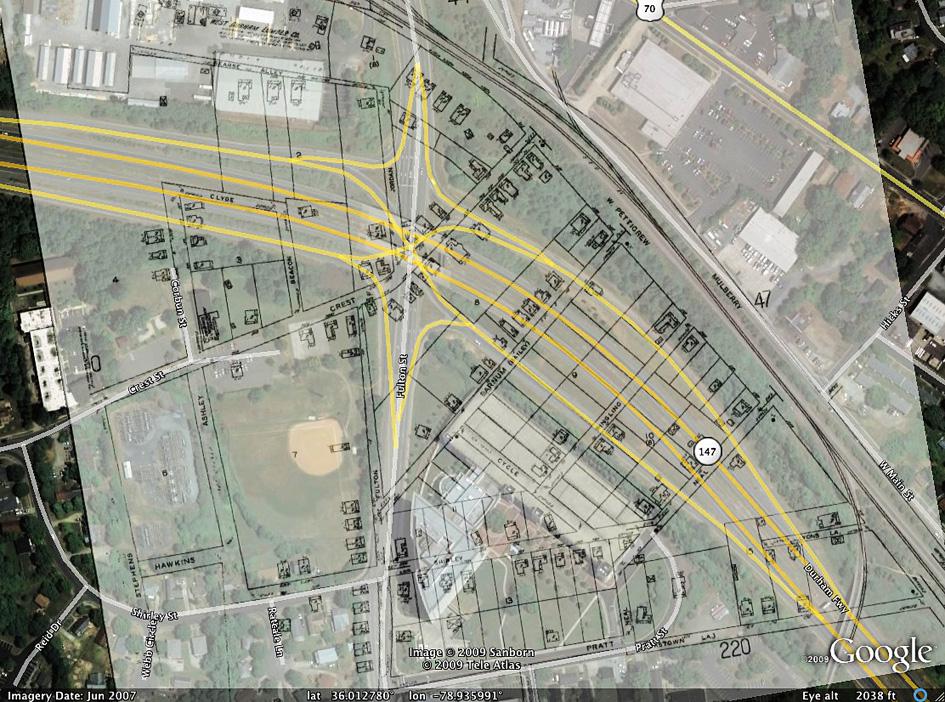
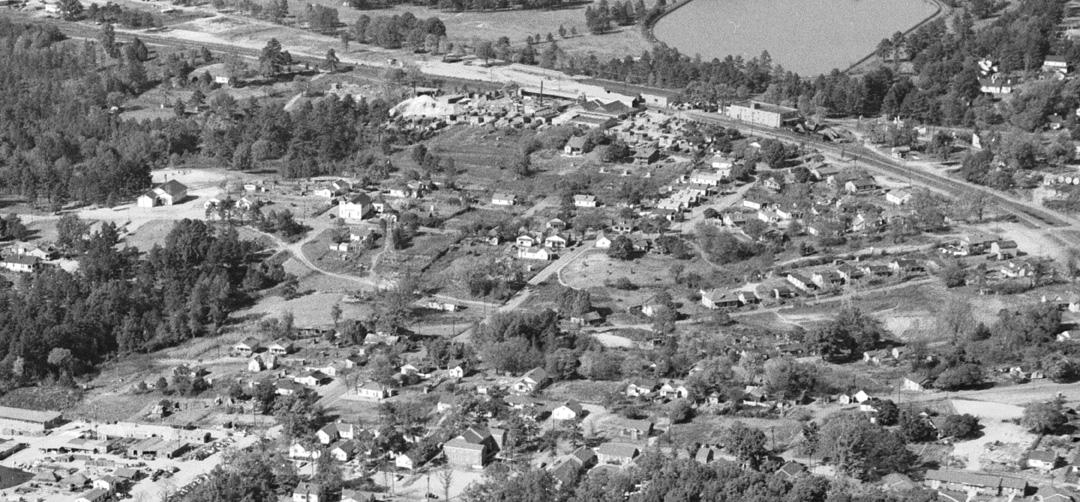
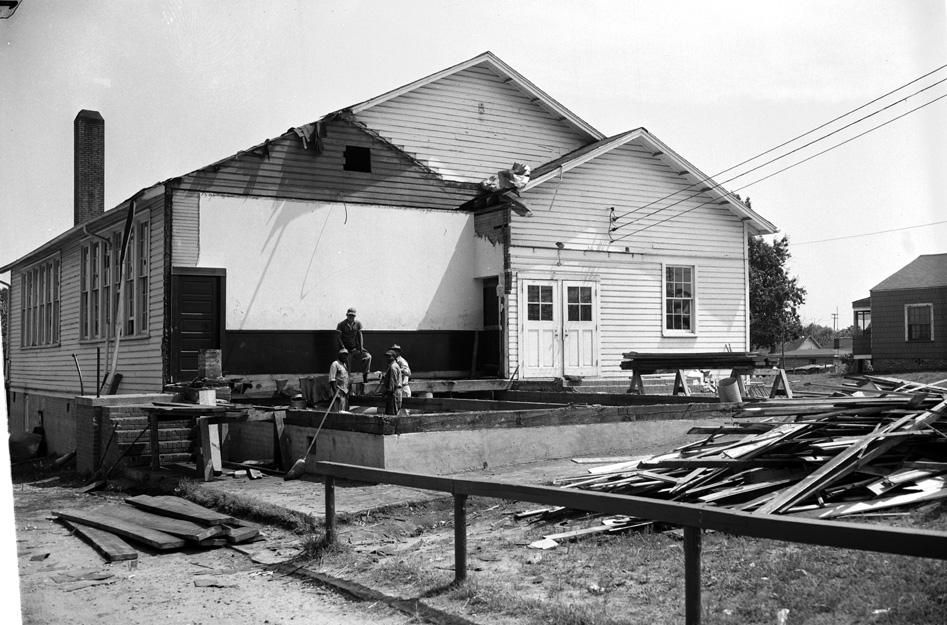
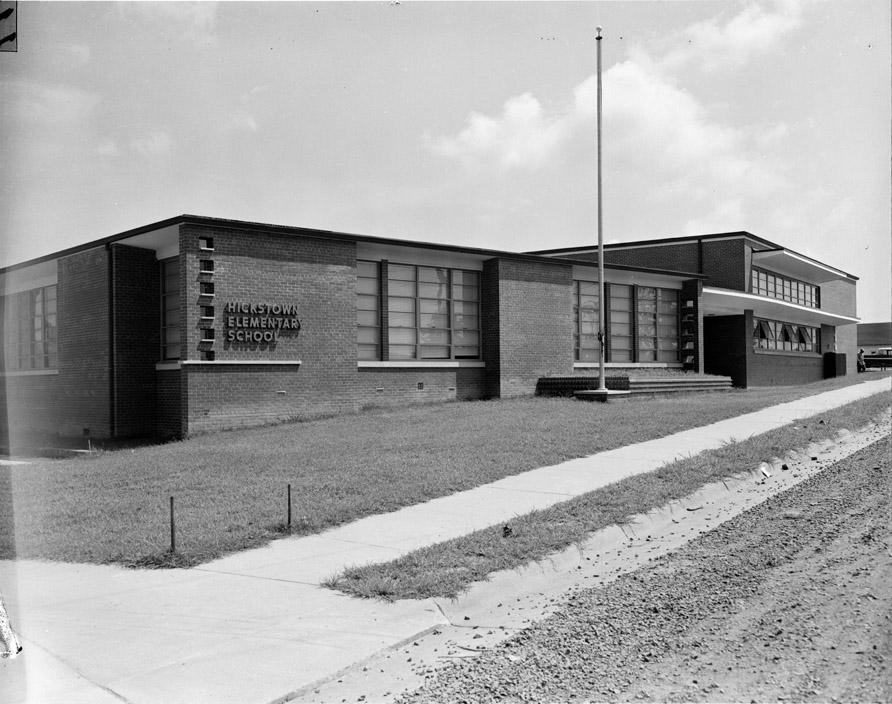
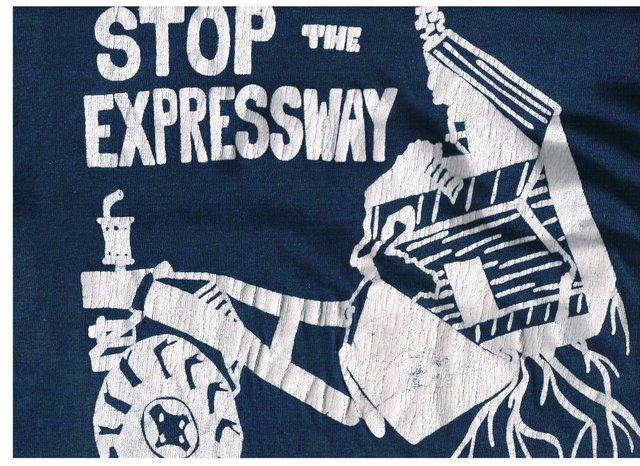
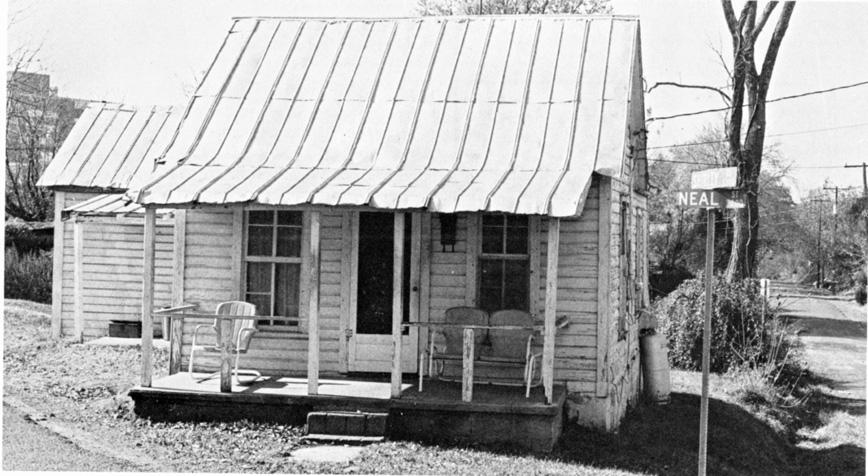
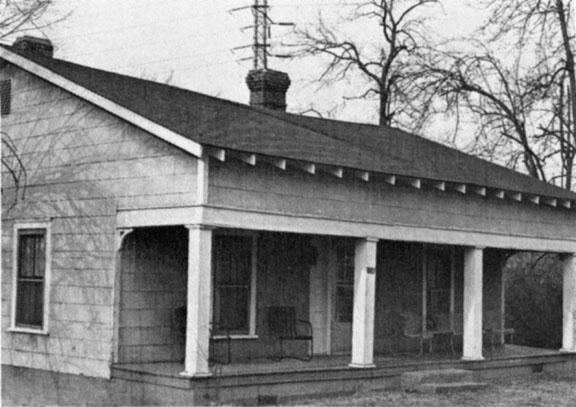
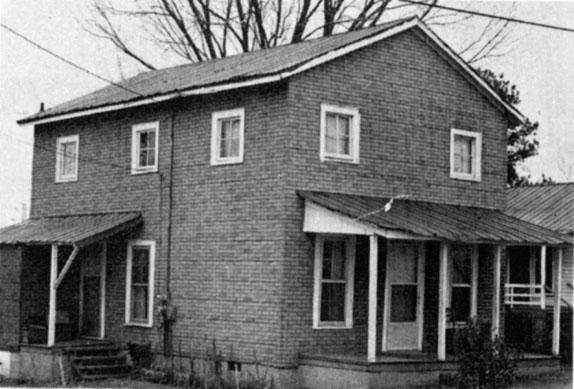
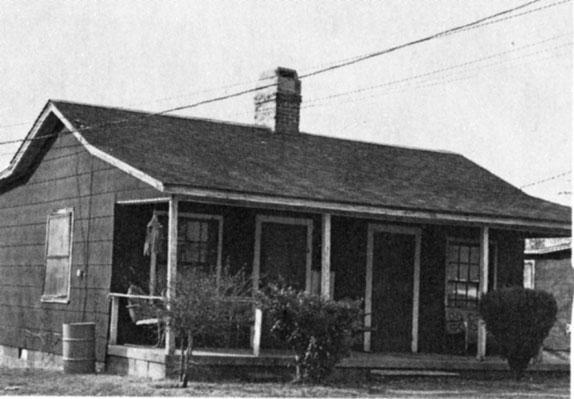
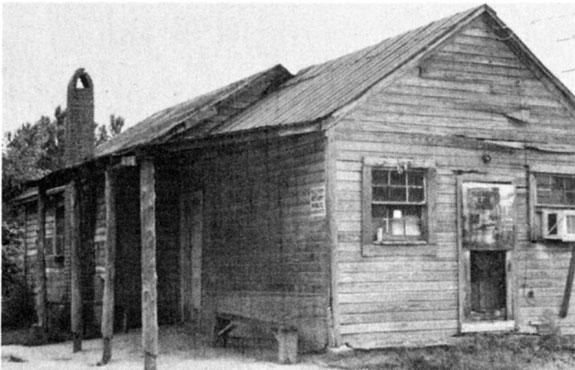
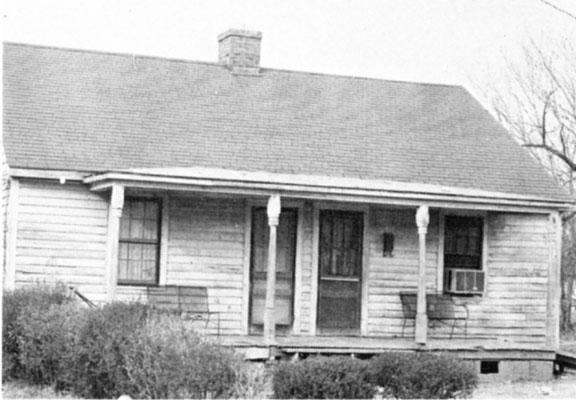
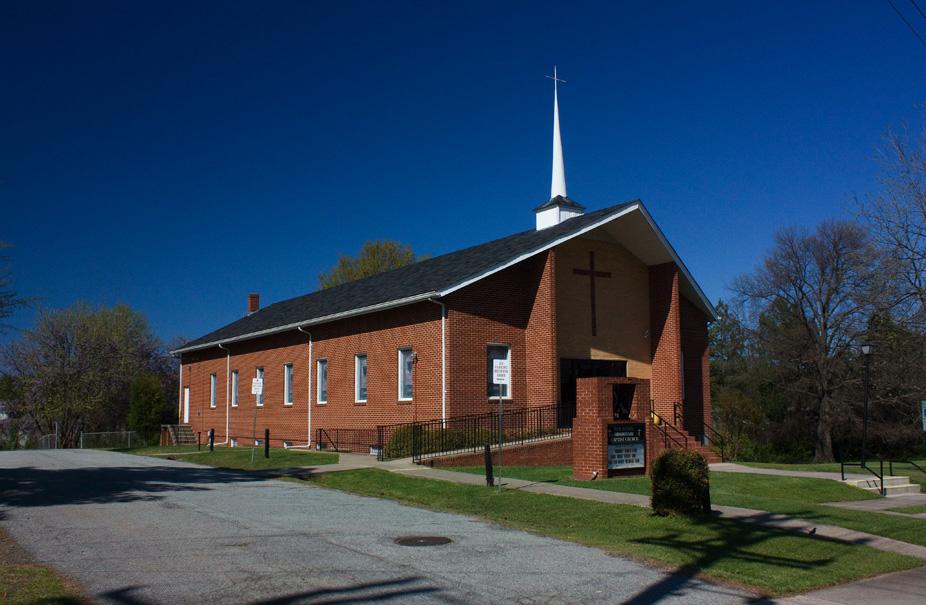
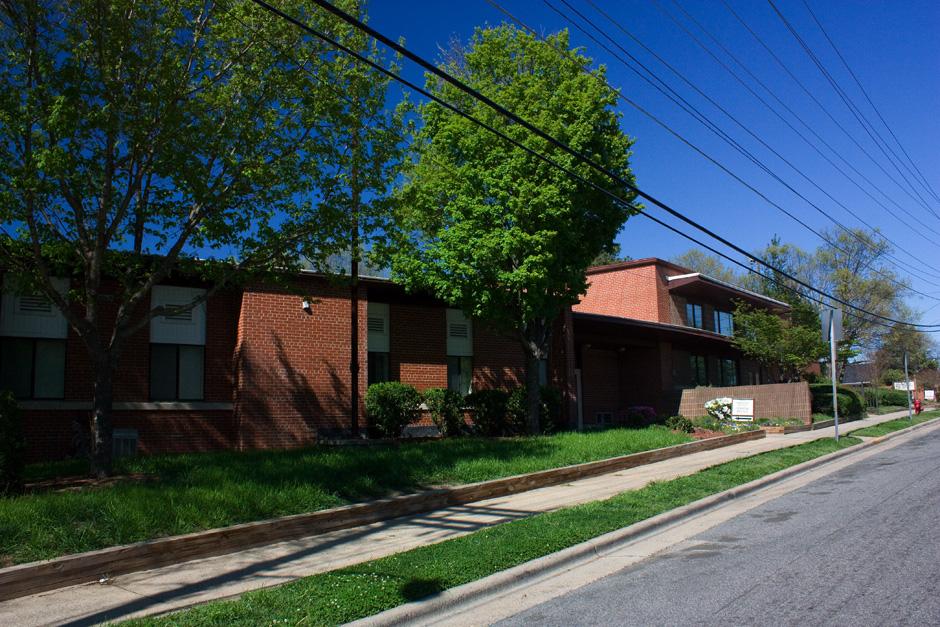
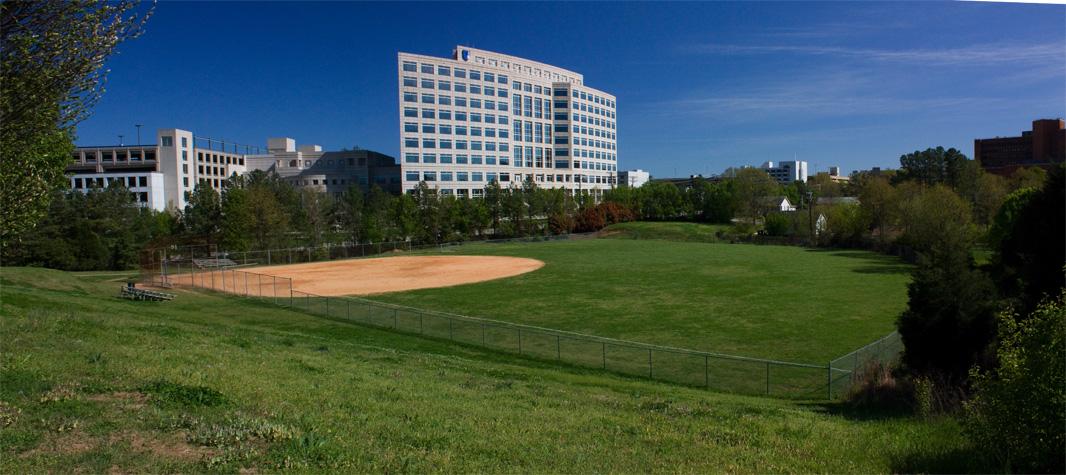
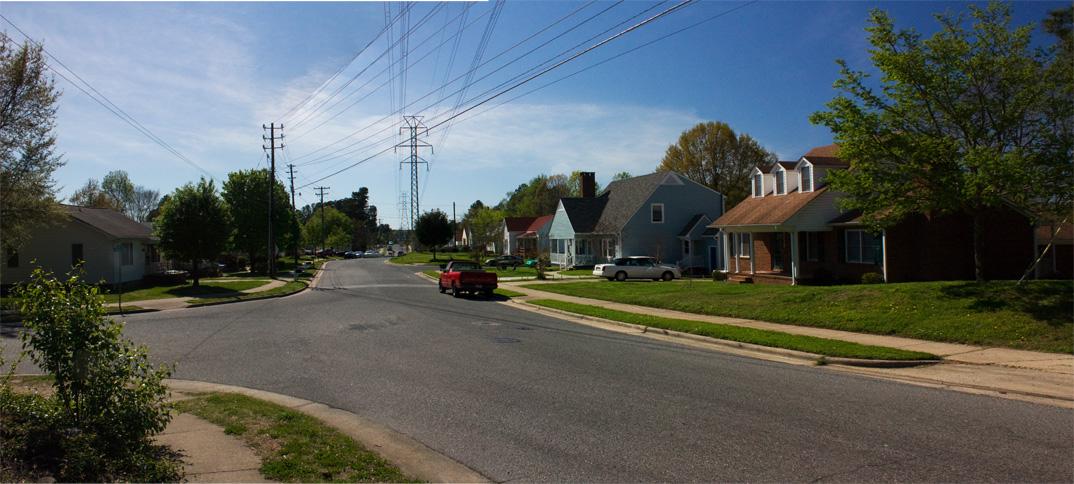
Comments
Submitted by Anonymous (not verified) on Sat, 5/2/2009 - 12:24am
Thanks for such a helpful and informative post. I live in west Durham and work in the medical area and greatly appreciate the recent work you've done on this part of town.
Submitted by John Schelp (not verified) on Sat, 5/2/2009 - 1:42am
From PA website...
"When City and State leaders sought to push the Durham Expressway through mostly African American neighborhoods, PA helped organize a City-wide coalition (1978-80). The coalition included NC Legal Assistance, students, concerned citizens and residents of the threatened community who worked to save the Crest Street neighborhood by rebuilding it near the VA medical center. PA led the political campaign that resulted in a $10 million settlement for the Crest Street community (negotiated by Legal Services attorneys). This settlement was the first time in U.S. history that highway relocation funds were used to benefit an entire neighborhood instead of individual homeowners..."
Source... http://durhampa.org/?page=accomp.php
Submitted by Lisa (not verified) on Sun, 5/3/2009 - 1:19am
I really enjoy this blog. I would be curious about the Old farm neighborhood in north durham. before i was born it was a popular place to live with people, and now it is section 8 housing in a large part. i grew up around there and now teach in the area, and am amazed at how it changed.
Submitted by Anonymous (not verified) on Sun, 5/3/2009 - 9:00pm
In response to Lisa's comment. I was wondering where is all of this section 8 housing located at in Old Farm neighborhood. You must be referring to the Carriage House Apt. complex and not the neighborhood itself. Old Farm is still a well maintained and good neighborhood to be from and live in.
Submitted by Dave Piatt (not verified) on Mon, 5/4/2009 - 1:37am
Almost any rental house can be eligible for Section 8, it takes only desire on the part of a property owner. Steps have been taken to help clean up Carriage House, but the economics of the situation prevent t from becoming the nice development it once was. Old Farm is still for the most part a decent neighborhood, but as older members pass or move and houses become rentals I fear what the future will hold for the area.
I did not know the history of the area, a great and thorough post. The neighborhood as it stands now is a little less than desirable, and I wonder how long it will be before Duke or an associated organization swallow it up for parking of office space.
Submitted by Erik (not verified) on Mon, 5/4/2009 - 4:32am
@Dave - I don't think you're grasping how remarkable this neighborhood move was. This case study is taught in planning schools across the country - there is no way anyone would touch that neighborhood...the politics of it would be devastating for whoever tried.
It's just incredible that both Crest Street (one of the best examples of mitigation due to a new highway) and Hayti (one of the worst) both occurred in Durham. Actually, I guess that's par for the course in Durham. Nevermind.
Submitted by otto (not verified) on Tue, 5/5/2009 - 1:12am
Great posting. I've driven through this area probably a couple hundred times in the last 14 years, never even realized there was a park there. Never would have guessed this neighborhood had such an interesting history.
Submitted by Mark Hellman (not verified) on Sun, 5/10/2009 - 8:58pm
Thanks for the post. It brings back a lot of memories. People's Alliance (PA) was founded in the fall of 1976 with strong chapters in Durham and Chapel Hill/Carrboro and small chapters in Greensboro, Winston-Salem, and Charlotte. As a multi-issue statewide organization, I think it would have been founded without the expressway fight. But the East-West Expressway was the primary focus of the Durham chapter in the late 70's and enlisted people who are still active in PA. The Durham chapter is the only one that still exists.
Paul Luebke, now a state representative, and others in PA organized the local political resistance, while Mike Calhoun and fellow attorneys at Legal Aid carried on the legal fight and negotiated with NCDOT.
Rep. Luebke and Steve Schewel can say more about this, but it is my understanding that other community groups initially saw the fight to save the community as unwinnable and stayed out of it.
The effort was partly funded by the sale of a "Stop the Expressway" t-shirt with a great design--the outline of a bulldozer uprooting a tree. John Schelp has mine for his West Durham historical collection. A photo of it would be a nice addition.
Submitted by Anonymous (not verified) on Thu, 4/1/2010 - 2:51am
PLEASE continue your good work in this area! My Ancestors are from here
Gill Parker
Submitted by Anonymous (not verified) on Thu, 4/1/2010 - 2:53am
Good work! I would love to help in anyway
919.946.9611
Gill Parker
Submitted by Anonymous (not verified) on Fri, 4/9/2010 - 8:06pm
The frame house located at the corner of Shirley and Neal street is where my Grandmother lived. Seeing the image of that house brought back lots of memories of visiting grandma in the house. I clearly remember the kitchen were there were lots of pies and cakes to be enjoyed.
Submitted by Anonymous (not verified) on Mon, 8/9/2010 - 12:21am
In 1957 I was born at Duke Hospital. I was raised in Hickstown and departed after Highschool. I attended 1st thru 6th grades at Crest Street Elementary School. (not Hickstown)
I don't know when the name was changed. But I choose to correct this record. I also would like to say thanks for the history lesson. the
Submitted by MAE (not verified) on Thu, 9/9/2010 - 1:43pm
I AM FROM HICKSTOWN THE SCHOOL WAS CREST STREET ELEM.LIKE MOST I LEFT AFTER GRADUATION,I REMEMBER A TIME WHEN NEIGHBORS ACTUALLY LOOKED AFTER AND RESPECTED EACH OTHER. THE KIDS HAD THE UP MOST RESPECT FOR THEIR ELDERS,NOW DRUGS HAS TAKEN OVER,ABUSE OF THE ELDERLY AND NOW A KILLING GROUND.
Submitted by septembergee (not verified) on Mon, 1/31/2011 - 5:03pm
Now I know why my mom calls the
community center the school house!
Thanks for the history lesson. My dad lives off of crest st. on zelko ct. The stories I have heard about the "Old Hickstown"-before the highway construction. My family were the owners of Nunn's Store, so seeing a picture of the store brought back a memory of how I got this scar on my inner wrist. There was a nail sticking out of the wooden column that holds the store up, so as I was going in circles around the column my wrist was snagged by the nail. I use to live on Zelko ct. and it was a nice, close net community in the 90's. Now it is a foreign place because of the outsiders from the section 8 housing placement. There has been gang related shootings and the distribution of drugs in the hickstown community that has made it undesirable to live and visit.
Submitted by Judah (not verified) on Tue, 12/6/2011 - 11:29am
I grew up in Hickstown. My parents bought a house there around 1978. I believe it was about five or six years later that I was aware that we would be relocated. A lot has changed in the New Hicktown. I am one of the kids who grew up and got pulled into living out everything that is wrong with Hicktown today. I was even part of some study at Duke in which some lady from Duke interviewed me from about first grade throghout middle school. She asked a lot of questions like "what would you do if you saw a purse full of money and no was around." Though I did get heavily caught up in the drug dealing culture of that neighborhood, I can honestly admit that I was as innocent as any other child, and I came from a broken but good morally conscious family. I attribute about 80% me falling into that lifestyle to being raised in poverty. I didn't come to the realization of how impoverished we all were until recent years, like within the last 3. The remainding 20% of what steered me down the wrong path was choice. When I was presented with the opportunity to hustle, just like anyone who sits on the sidelines and wags their head at what Hicktown has become, if you were in my shoes (Black male growing up in the late 80s early 90s), I guantee that you that there is an 80% chance that you would have done the same. In fact, I can't think of one out of 10 random guys that I grew up with that didn't do something. Maybe there was one out of 20 who were fortunate enough to escape what I see today as an incubaor for a hopeless future. Its ironic that after Eve Carson got killed, I remember reading the Herald Sun online. Some one slammed Mayor Bill Bell in the comment section: "Bill Bell said that if we were not apart of crime then we didn't have anything to worry about." That person went on complaining that Bill Bell was so wrong. I remember shaking my head and thinking: "You got to be kidding me. You are not upset that there has been many innocent kids killed 'across the tracks,' but instead your upset that now you are forced to be concerned because its happened on your side. People who make comments like that are part of the new politically correct attitude ascribe to Blacks: Our community has no excuse to be in the condition it is in. Everyone has a free will. If people hold to that thought, in essence, what they are really saying is that the more than probably 90% of Black male youth, over 16 years of age, that are involved in selling drugs in Hicktown are doing so because that is what they wanted in life. Yes. They had every opportunity to do well and make better decision. Yes. Many are tired of Blacks making excuses about their condition. I would agree partly to that. However when you commit wholely to that thought, it is emotionally unintelligent to do so. The reason it has become the norm to not acknowledge that there are reasonable excuses, then someone would have to take some responsibility and help. Duke, who at one time had the most employees in Durham, would be able to just not hire me because I had a felony (which did happen to me and many other who were trying to find another way). This would mean that churches would have to stop going oversees "digging wells" in 3rd world countries, when they have 3rd world cities down the street.
Submitted by Joe (not verified) on Wed, 1/2/2013 - 1:54am
One problem for Hickstown these days is that Shirley-Cress-Douglas represents a shortcut for folks traveling from north on Fulton to the Erwin/Research Drive intersection. One can avoid two lights (including the no right turn on red at Fulton and Erwin) and the potential traffic jams that arise from the bus stops and VA entrances on Erwin. Speed bumps cut down on this some, but with increased and continued building on Erwin west of Fulton, these streets will see continued increases in traffic. If you happen to use this shortcut-- think about avoiding it next time. Having your street serve as a short cut for others, which inevitably includes a minority who speed/litter/etc. can be demoralizing-- I lived with a similar situation for many years.
Submitted by Leroy Landis (not verified) on Mon, 7/22/2013 - 4:15pm
Wow!! I too remember this house, it was the Glovers. As I also grew up in Hickstown on the corner of Barnum & Cycle St. Although the houses may look a bit shabby in the circa photo's, it was a community of loving and proud people. My fondest childhood memories are from going to school at Crest Street Elementary and playing barefoot in the summer.
Add new comment
Log in or register to post comments.